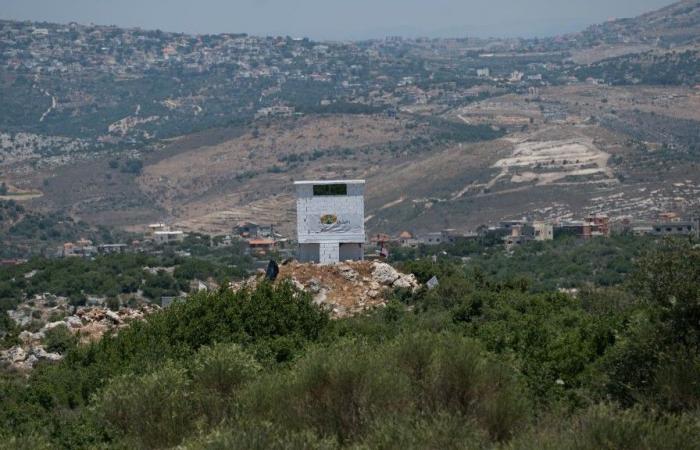Last week, the Israeli military launched a series of airstrikes across Lebanon, targeting branches of Al-Qard Al-Hassan (AQAH), an unlicensed credit association believed to be the bank of the Lebanese Shiite terrorist group. of Hezbollah.
These strikes marked a change of direction. While the army only targeted military targets, it began attacking ostensibly civilian infrastructure, underscoring the challenges posed by the terrorist group’s deep penetration into Lebanese society.
Because of its networks of social organizations, dispensaries, and extensive patronage system among Shiites, extirpating Hezbollah from the Lebanese civil fabric may prove more complicated and difficult than destroying the group’s armed capabilities. Lebanese Shiite terrorist supported by Iran.
Receive our daily edition for free by email so you don’t miss the best news. Free registration!
Hezbollah as it existed before the launch of the ground operation no longer exists, “but it is still dangerous and it is not going to disappear,” says Matthew Levitt, Hezbollah expert, at Times of Israel during a recent telephone conversation.
Protesters holding photos of Hassan Nasrallah, the late leader of the Lebanese Shiite terrorist group Hezbollah, during a protest vigil in the southern Lebanese city of Sidon on September 28, 2024. (Mahmoud Zayyat/AFP )
“Hezbollah is truly a movement. It is not just a terrorist organization, a militia or a political party. He is also deeply involved in social and religious activities,” said Levitt, a senior fellow at the Washington Institute for Near East Policy and a former FBI counterterrorism expert.
Hezbollah’s armed capabilities are weakened and visibly crumbling. Last week, the Israeli military said it had eliminated more than 2,000 elements of the Iranian-backed Lebanese Shiite terrorist group since October 2023, including many of its commanders, and destroyed around 70 to 80 percent of the rockets it he owned before the war. It also claimed to have defeated Hezbollah in all areas where its troops operated in southern Lebanon.
Although the terrorist group recently named a new leader, Naim Qassem, to replace its eliminated secretary general, Hassan Nasrallah, it is unclear who is directing the strategy of the terrorist group’s armed wing on the ground.
However, “much of Hezbollah’s social affairs infrastructure remains intact as the IDF targets its weapons caches and command and control centers. They do not target health clinics and social programs controlled by Hezbollah,” Levitt said.
The Hezbollah expert described the terrorist group’s wide range of social activities as “shadow governance,” providing essential services to a country long on the brink of financial and political collapse, plagued by a permanent corruption, sectarian struggles and powerful elite families. This has created a “ghost district” that relies on his assistance, Levitt said.
“Hezbollah today enjoys the best of both worlds: it is part of the Lebanese state, with its members holding ministerial positions and seats in Parliament, but it remains an independent group that operates outside the state ” Levitt wrote in a recent report for the Washington Institute. Thus, “this avoids him having to assume the responsibility of accountability which generally goes hand in hand with the exercise of an elective mandate”.
Hezbollah’s vast network of charitable organizations
The AQAH Financial Group was founded by Hezbollah in 1983, a year after the terrorist group’s creation, to provide interest-free loans in accordance with Islamic Sharia principles. Over the years, AQAH has become a major financial institution with branches in all Hezbollah strongholds in Lebanon.

A man riding a moped past the site of an IDF airstrike that targeted a branch of Al-Qard Al-Hassan, an unlicensed credit association believed to be Hezbollah’s bank, in the southern suburbs of Beirut, on October 21, 2024. (Credit: AFP)
The United States blacklisted AQAH in 2007, saying Hezbollah uses it as a front to manage the Lebanese Shiite terrorist group’s financial activities and gain access to the international financial system.
However, Hezbollah’s civilian infrastructure goes well beyond that, constituting a system of patronage that fills the gaps in the Lebanese government’s ineffectiveness and strengthens its influence among the country’s Shiite community, which numbers some 2 million people, effectively creating a Shiite “mini-state”.
It includes a network of hospital centers known as the Islamic Health Organization, which provides free or discounted health services to Shiites, while treating injured Hezbollah terrorists, according to the Israel Information Center intelligence and terrorism Meir Amit.
In 2021, Hezbollah also launched the Al-Sajjad supermarket chain, named after a revered figure in Shiite Islam. These supermarkets sell products (often of Iranian, Syrian or Iraqi origin) at significantly reduced prices to customers who present Hezbollah-issued cards.
Additionally, Hezbollah controls a chain of gas stations, the Amana Petroleum Company, which sells Iranian fuel at discounted prices, sometimes in defiance of the Lebanese government. It has been the subject of American sanctions since 2020.
Hezbollah’s construction arm, Jihad al-Bina, was instrumental in rebuilding areas destroyed during the Second Lebanon War in 2006. Today, the foundation, established in 1988, manages various construction projects. large-scale in the fields of civil engineering, agriculture and industry, and controls vocational training centers, according to the Meir Amit Center.
On the propaganda front, Hezbollah controls its own television channel, Al-Manar, and various school programs, including a youth group known as the Mahdi Scouts, used to indoctrinate Shiite youth, according to the IDF.
The terrorist group also claims to be involved in environmental protection. He runs Green Without Borders, a nonprofit organization that claims to manage reforestation projects in southern Lebanon. According to Israel, the group actually serves as a cover for Hezbollah’s positions; he was sanctioned by the United States for alleged terrorist activities last year.

An installation of the Lebanese NGO “Green Without Borders”, which, according to the Israeli army, serves as an outpost for Hezbollah on the Israeli-Lebanese border, published on June 22, 2017. (Credit: Border Guard Unit words of the Israeli army)
Hezbollah’s financial difficulties
Last week, the army revealed it had located a Hezbollah bunker beneath a Beirut hospital. According to the IDF, more than $500 million in gold and cash was stored by the terrorist group inside this bunker.
Despite its fortunes, Hezbollah is reportedly experiencing a liquidity crisis, with IDF airstrikes on AQAH branches likely adding to the growing financial pressure on the Iranian proxy.
Lebanese and foreign sources cited in a recent article in Voice of America (VOA) claimed that Hezbollah was cash-strapped and unable to pay its members. Its access to Lebanon’s official banking system is also reportedly restricted, with the country’s richest bankers having fled abroad, fearing being targeted by Israel for aiding Hezbollah, according to VOA.

Families sit on the ground in Martyrs’ Square after fleeing Israeli airstrikes, in the southern suburbs of Beirut, September 28, 2024. (Credit: Bilal Hussein/AP)
Until recently, the terrorist group was awash in cash, thanks to Iranian fund transfers and its own illicit activities, foremost among which its (very) vast international narcotics smuggling network, according to experts. Hezbollah used this cash to satisfy its Shiite voters, paying them monthly stipends in stable foreign currencies.
A Shiite woman recently evacuated from southern Lebanon to Beirut told Guardian that the Lebanese Shiite terrorist group had distributed monthly payments of $200 in cash, as well as food parcels, praising them for “taking incredible care” of his family.
It is unclear how long Hezbollah will be able to continue making these payments. The social affairs network is also facing a manpower shortage, as many Hezbollah elements who worked in the charities have been called into combat or are unable to do so due to injuries sustained in the explosions beepers and talkies-walkies which took place in September.
In addition, the displacement of more than a million people from Shia-majority areas of southern Lebanon and elsewhere has placed additional pressure on the informal welfare system.
“This is another significant level of demands at a time when resources are dwindling and demands for those resources are competing,” Levitt said.
Will Hezbollah turn its weapons against the Lebanese?
As Israel works to dismantle Hezbollah’s armed and financial capabilities, the terror group may have to invest in weapons rather than civilian spending or its social infrastructure to maintain its hold on Lebanon, Levitt warned. . The Lebanese Shiite terrorist group has a long history of using violence to suppress its critics.
With Iran’s support, the terrorist group will likely attempt to rearm and refill its coffers at the first opportunity. It remains unclear whether the international community would be able to intervene to prevent Tehran’s influence from seeping into Lebanon, and whether the Lebanese Armed Forces (LAF) would be able to reassert their sovereignty and monopoly on State on the legitimate use of force, Levitt added.
“Hezbollah will fight hard to prevent it,” he predicted.
“And it will still have the means to do so even when Israel has eliminated a significant part of its strategic threat. »







